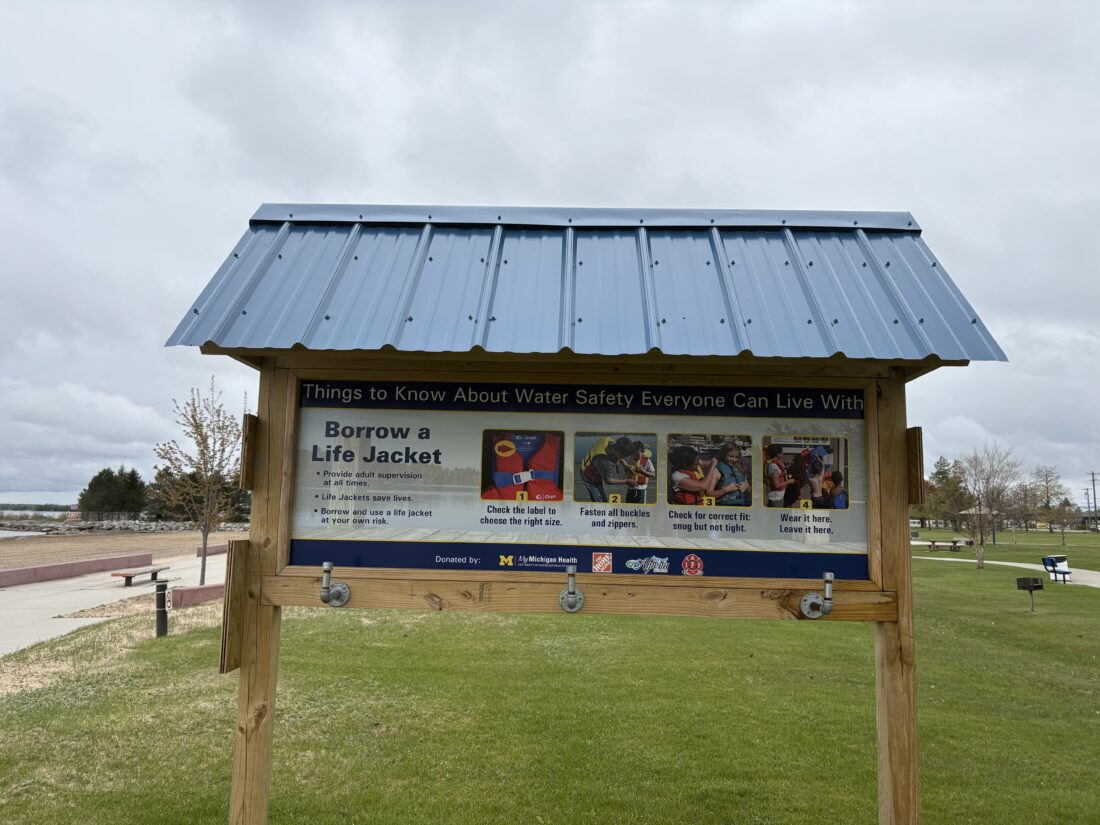Promoting safe swimming practices
Water temperatures, unmarked swimming areas pose risks

News Photo by Kayla Wikaryasz The Starlite Beach’s Borrow a Life Jacket site is seen at Starlite Beach on Thursday. Loaner life jackets are typically held at this station and the one at Thomson Park beach.
ALPENA — May is National Water Safety Month. The District Health Department No. 4 (DHD4) and the Michigan Department of Natural Resources (DNR) shared recommendations with Michigan residents as to how they can safely enjoy water activities.
According to a DHD4 press release, National Water Safety Month emphasizes the importance of water safety by promoting safe swimming practices.
“Northeast Michigan is known for beautiful Lake Huron, many inland lakes, and household pools, recognizing it only takes a moment to drown,” DHD4 health officer, Denise Bryan, said in the press release. “Having good water competency helps everyone avoid common dangers, especially in unfamiliar water.”
The press release notes Red Cross’ safety tips that include the following: swim sober, know your limitations, never swim alone, and wear a US Coast Guard-approved life jacket when boating. Individuals should also understand the unique risks of bodies of water (river currents, water temperatures, shallow/deep water, and underwater hazards.
The DNR also has recommendations as the weather continues to warm and Michigan residents begin to engage in more water recreation activities.

News Photo by Kayla Wikaryasz The Alpena Marina is quiet on Thursday evening. Boaters are starting to get their boats in the water as the weather heats up and summer nears.
A DNR press release reminds Michigan residents of strong currents in the Great Lakes that can present unique challenges to all swimmers, no matter their swimming ability.
Pat Whalen, supervisor for the DNR Parks and Recreation Division, explained that cold water temperatures pose unique risks this Memorial Day weekend.
“We want to remind our visitors to be cautious of cold-water temperatures,” Whalen said in the press release. “Sudden immersion and/or sustained time in cold water can cause cold shock, making it hard to breathe and increasing your risk of drowning.”
Additionally, Whalen said that cold shock can cause individuals to gasp for air while underwater, further increasing an individual’s risk of drowning.
Besides cold shock, Whalen said the cold water temperatures this year pose hypothermia risks, as well, and people choosing to swim should be cautious of the amount of time they spend in the water.
Also, due to the cold water temperatures in some areas, the DNR has yet to finish installing and marking buoyed swim areas, according to Whalen. He said that for the safety of DNR staff, some DNR-managed sites will not have swim areas marked for Memorial Day weekend.
Whalen explained that the DNR does not recommend that individuals swim past buoyed swim areas; these buoyed swim areas are monitored and inspected every two weeks to ensure that the water depth does not exceed five feet and that the water quality does not pose a significant risk to people’s health.
Because Great Lakes’ sandbars have a tendency to shift, causing drop-offs to occur when they might not have been present a few weeks prior, Whalen explained that frequent monitoring of these sites is necessary as the summer season ramps up.
Further, Whalen noted piers as another risk to individuals, as some try to jump off piers, thinking that the water depth is deep enough for such an activity. Whalen explained that water depths can be misleading, and there are sometimes large rocks under the surface.
In general, Whalen said individuals swimming in the Great Lakes should pay special attention to the DNR flag system: double red flags (water access is closed), a single red flag (high hazard), a yellow flag (medium hazard), and a green flag (low hazard). If a DNR-managed site shows a double red flag, individuals can still use the beach, but by law are not allowed to enter the water.
In addition to the DNR flag system, Whalen recommended that individuals pay attention to signage around DNR-managed sites that instruct individuals as to how to escape a rip current. Whalen said individuals stuck in a rip current should do the following: flip onto your back, float with the current, follow a path perpendicular to the flow until you can break from the current, and then swim back to shore.
National Water Safety Month is also a time to consider water quality.
DHD4 works with the Department of Environment, Great Lakes, and Energy (EGLE) and the Michigan Department of Health and Human Services (MDHHS) to test the water quality of beaches for several hazards, including E. coli, and monitor them for the presence of harmful algae blooms (HAB).
“When E. coli levels get too high, it can cause flu-like symptoms, skin infections, and upper respiratory illnesses,” DHD4 environmental health director Kevin Prevost said in the press release. “HABs can also be harmful to humans and can be fatal to pets. When a test comes back with elevated E. coli levels, or confirms the presence of a HAB, we issue a No Water Contact Advisory and post signage where the samples were collected. Testing continues until the HAB is no longer present or the E. coli levels have been reduced to a safe level.”
Prevost stated in the press release that residents can check the water quality of a beach or lake by visiting EGLE’s BeachGuard at mienviro.michigan.gov/ncore.
- News Photo by Kayla Wikaryasz The Starlite Beach’s Borrow a Life Jacket site is seen at Starlite Beach on Thursday. Loaner life jackets are typically held at this station and the one at Thomson Park beach.
- News Photo by Kayla Wikaryasz The Alpena Marina is quiet on Thursday evening. Boaters are starting to get their boats in the water as the weather heats up and summer nears.







